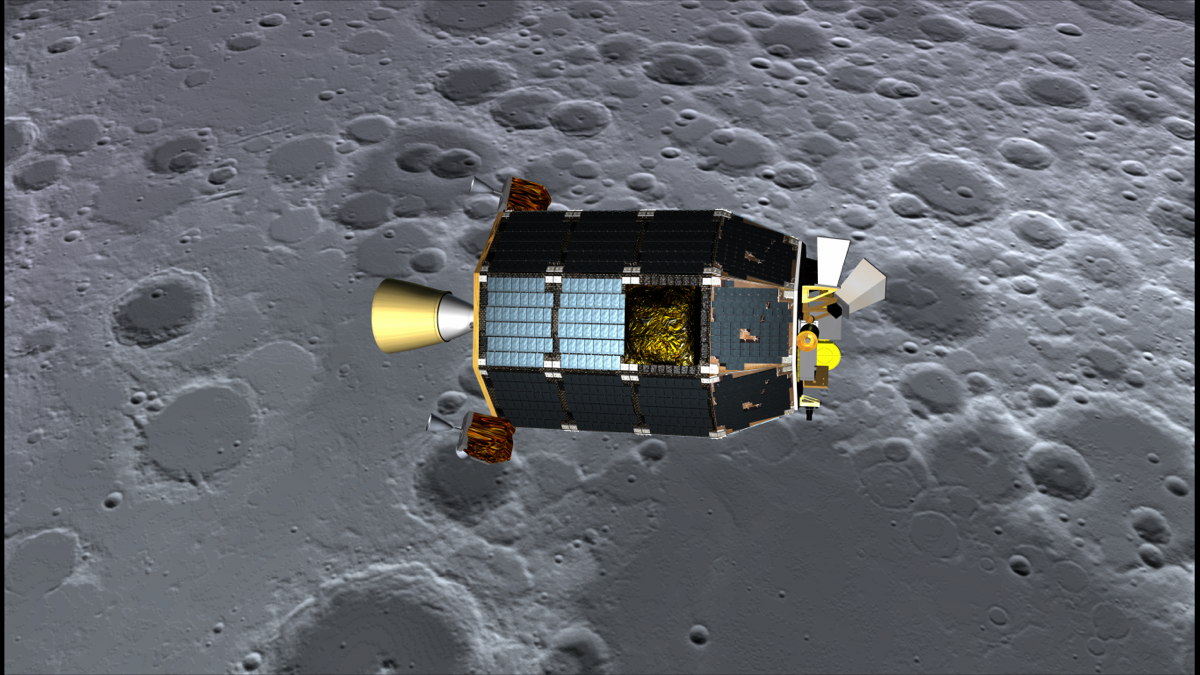LADEE: NASA's Moon Mission to Study Lunar Dust Secrets

NASA's Lunar Atmosphere and Dust Environment Explorer (LADEE) — pronounced "laddie," not "lady" — launched Sept. 6, 2013, for a mission to the lunar surface. The spacecraft ended its mission on April 18, 2014, when it was intentionally crashed into the surface of the moon after running low on fuel.
The 844-pound (383 kilograms) spacecraft orbited the moon between October 2013 and April 2014. It investigated lunar dust, the lunar atmosphere and conditions near the moon's surface, NASA officials have said.
"While we know Earth's atmosphere has oxygen, we do not know what comprises the moon's atmosphere," NASA officials wrote in a fact sheet. "To help us understand what it contains, LADEE will dip into the lunar atmosphere, and instruments onboard the spacecraft will send detailed measurements to scientists to analyze on Earth." [Photos: NASA's LADEE Moon Dust Mission in Pictures]
Lunar atmosphere?
The moon's atmosphere is much thinner than Earth's. Scientists suspect that the lunar atmosphere is about 1/100,000th the density of Earth.
Because the atmosphere is so thin, temperatures reach 273 degrees Fahrenheit (134 degrees Celsius) on the sunny side of the moon, but the temperature can get as cold as minus 243 degrees Fahrenheit (minus 153 degrees Celsius) on the far side of the moon.
The moon's atmosphere can be compared to the fringes of Earth's atmosphere, right above the area of space where the International Space Station orbits, NASA officials have said. Scientists also suspect that the moon's atmosphere could be analogous to the atmospheres of other relatively small planetary bodies throughout the solar system.
Following in lunar footsteps
LADEE is the latest in a long line of probes NASA has sent to the moon.
Breaking space news, the latest updates on rocket launches, skywatching events and more!
The space agency's Pioneer 4 completed the first successful American flyby of the moon in 1959. The Soviet spacecraft Luna 1 successfully flew by the moon a few months earlier. [How NASA's LADEE Spacecraft Works (Infographic)]
In 2011, the Lunar Reconnaissance Orbiter sent back the most high-resolution moon map ever constructed.
That same year, the twin GRAIL (Gravity Recovery And Interior Laboratory-A) spacecraft launched. The two probes, responsible for investigating the structure of the lunar interior, were purposefully crashed into the moon in December 2012.
LADEE's Science
The LADEE spacecraft comes equipped with three science instruments and a technology demonstration:
- Ultraviolet and Visible Light Spectrometer – This instrument will analyze the light signatures of materials around the moon to understand the composition of the satellite's atmosphere.
- Lunar Dust Experiment – This instrument will collect and analyze moon dust in the atmosphere. The instrument could also help NASA scientists solve a mystery, NASA officials wrote in a facts sheet: "Was lunar dust, electrically charged by solar ultraviolet light, responsible for the pre-sunrise horizon glow that the Apollo astronauts saw?"
- Neutral Mass Spectrometer – The spectrometer will look for variations in the lunar atmosphere while the moon is in different orbits and various space environments, according to NASA officials.
- Lunar Laser Communications Demonstration – For this technology demonstration, LADEE will use lasers (and not radio waves, like other spacecraft that have flown beyond close Earth orbit have used) to communicate with controllers on Earth. This could allow the spacecraft to communicate at broadband speeds with the ground.
A history-making launch
The LADEE launch was the first lunar mission to launch from NASA's Goddard Space Flight Center's Wallops Flight Facility in Virginia. This mission also marked the first time a payload has been launched aboard a U.S. Air Force Minotaur V rocket integrated by Orbital Sciences Corp., NASA officials have said.
Once launched, the probe took about 30 days to get to the moon; LADEE then went through a checkout period for another 30 days. After that, the probe was scheduled to conduct 100 days of science operations.
NASA's LADEE mission cost $280 million and did last longer than its designed lifetime. In February 2014, NASA officially extended the mission to mid-April as fuel was beginning to run low. At the time, mission managers expected the probe to crash into the moon by April 21.
Ending with a bang
The final crash occurred on April 18 between 12:30 a.m. EDT (0430 GMT) and 1:22 a.m. EDT (0522 GMT).
LADEE crashed into the moon about 0.5 miles (0.8 kilometers) from the eastern rim of the larger Sundman V crater, just 0.2 miles (0.3 km) north of the spot where mission team members predicted the spacecraft would go down based on tracking data, NASA officials said in October 2014. The agency's Lunar Reconnaissance Orbiter took a photo of the crater caused by LADEE when it crashed.

Miriam Kramer joined Space.com as a Staff Writer in December 2012. Since then, she has floated in weightlessness on a zero-gravity flight, felt the pull of 4-Gs in a trainer aircraft and watched rockets soar into space from Florida and Virginia. She also served as Space.com's lead space entertainment reporter, and enjoys all aspects of space news, astronomy and commercial spaceflight. Miriam has also presented space stories during live interviews with Fox News and other TV and radio outlets. She originally hails from Knoxville, Tennessee where she and her family would take trips to dark spots on the outskirts of town to watch meteor showers every year. She loves to travel and one day hopes to see the northern lights in person. Miriam is currently a space reporter with Axios, writing the Axios Space newsletter. You can follow Miriam on Twitter.
